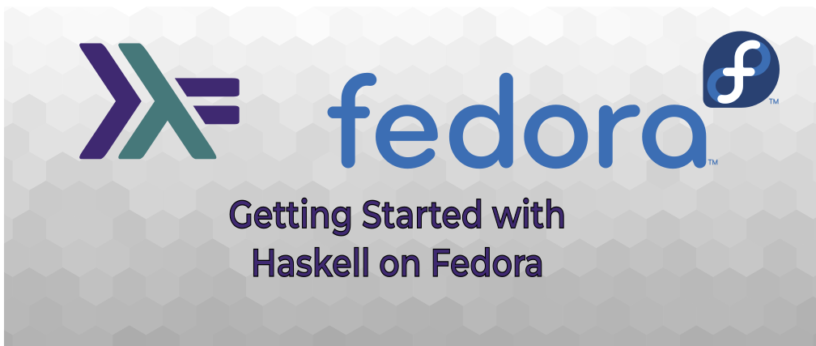Haskell is a functional programming language. To create a program, the user applies and composes functions, in comparison to imperative languages, which use procedural statements.
Haskell features state-of-the-art programming paradigms that can be used for general purpose programs, research, and industrial applications. Most notably, it is purely functional using an advanced type system, which means that every computation, even the ones that produce side-effecting IO operations, are defined using pure functions in the mathematical sense.
Some of the main reasons for Haskell’s increasing popularity are ease of maintenance, extensive packages, multi-core performance, and language safety against some bugs, such as null pointers or deadlock. So let’s see how to get started with Haskell on Fedora.
Install Haskell in Fedora
Fedora provides an easy way to install the Glasgow Haskell Compiler (GHC) via the official repository:
$ sudo dnf install -y ghc $ ghc --version The Glorious Glasgow Haskell Compilation System, version 8.6.5
Now that GHC is installed, let’s write a simple program, compile it, and execute it.
First program in Haskell
Let’s write the traditional “Hello, World!” program in Haskell. First, create a main.hs file, and then type or copy the following.
main = putStrLn ("Hello, World!")
Running this program is quite simple.
$ runhaskell main.hs Hello, World!
Building an executable of the program is as simple as running it.
$ ghc main.hs [1 of 1] Compiling Main ( main.hs, main.o ) Linking main ... $ ./main Hello, World!
GHC provides a Read Eval Print Loop (REPL) command to interactively evaluate Haskell expressions.
$ ghci Prelude> :load main.hs [1 of 1] Compiling Main ( main.hs, interpreted ) Ok, one module loaded. *Main> main Hello, World! *Main> :type putStrLn putStrLn :: String -> IO () *Main> :info String type String = [Char] -- Defined in ‘GHC.Base’ *Main> :help ...
The most common REPL commands are:
- :load loads a file.
- :reload reloads loaded files.
- :type shows the type of an expression.
- :info displays information about a name.
- :browse lists the loaded functions.
Using Haskell packages
Haskell features a package system to share functions.
To show how to use packages, let’s write a new one. First, create a MyPackage.hs file, and then, type or copy the following.
module MyPackage where
greet name = putStrLn ("Hello, " ++ name ++ "!")
Next, modify the main.hs file as follow:
import MyPackage
main = greet ("Fedora")
In the modified main.hs, instead of using the standard putStrLn function to print the “Hello, World!” the application now uses the greet function from the newly created package:
$ runhaskell main.hs Hello, Fedora!
GHC automatically looks for packages in the current working directory, and it can also looks for packages installed globally on the system. To use a Fedora package in your Haskell project, you need to install the development files. For example, let’s use the ansi-wl-pprint library to add color:
$ sudo dnf install -y ghc-ansi-wl-pprint-devel
Next, modify the MyPackage.hs file:
module MyPackage where
import Text.PrettyPrint.ANSI.Leijen
greet name = putDoc (green (text ("Hello, " ++ name ++ "!\n")))
Then you can build a small executable using dynamic links:
$ ghc -dynamic main.hs -o greet && strip greet
[1 of 2] Compiling MyPackage ( MyPackage.hs, MyPackage.o )
[2 of 2] Compiling Main ( main.hs, main.o )
Linking greet ...
$ du --si greet
17k greet
$ ./greet
Hello, Fedora!
This concludes how to get started with Haskell on Fedora. You can find the Haskell SIG (Special Interests Groups) on Freenode IRC in #fedora-haskell, or in the mailing list
Learning resources
Haskell may be daunting because it supports many advanced concepts such as GADTs or type-level programing. However, the basics are quite accessible and they are more than enough to reap the majority of benefits and reliably deliver quality software.
To learn more about the language, here are some further resources:






tierno sow
Fantastique! J’en rêve depuis longtemps et ça marche.
Installé sur Fedora32
WagaDagaBeem
Très magnifique!
Spencer
Great, one more source for Haskell for my collection! Congratulations.
Still, my favorite is serokell.io/blog. I always get answers to my questions there.
Keep watching.
Gilad
Very happy to see my favorite language featured on my favorite distro!
0mfq
Great topic for reading during pandemic. I am conducting research for online studying https://www.0mfq.com/ where students can share their opinions before classes start. Great for course topic choices.
InfiniteDonuts
Another learning source: learnyouahaskell.com (I learned Haskell there, it’s a great tutorial).
Jens Petersen
Thanks, Tristan, for this article.
Besides a lot of good online introductory material, there are a couple of recent introductory books I also like:
“Get Programming with Haskell” by Will Kurt (Manning)
https://atypeofprogramming.com/ by Renzo Carbonara (WIP)
A lot of people also swear by Graham Hutton’s textbook “Programming in Haskell” (2nd ed)
Les B Labbauf
Haskell? Gordon Haskell 😛